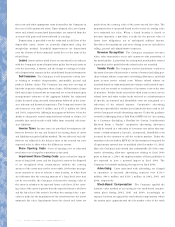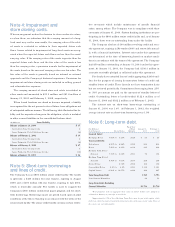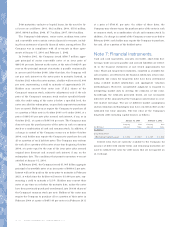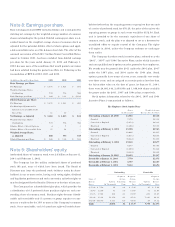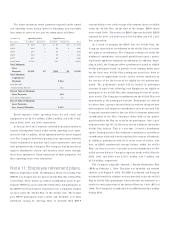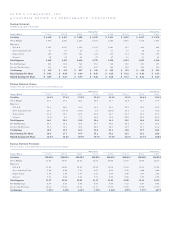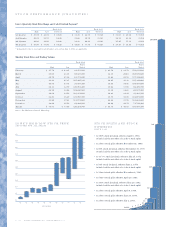Lowe's 2002 Annual Report Download - page 39
Download and view the complete annual report
Please find page 39 of the 2002 Lowe's annual report below. You can navigate through the pages in the report by either clicking on the pages listed below, or by using the keyword search tool below to find specific information within the annual report.
The future minimum rental payments required under capital
and operating leases having initial or remaining non-cancelable
lease terms in excess of one year are summarized as follows:
(In Millions) Operating Leases Capital Leases
–––––––––––––––––––––––––––––––––––––––––––––––––––––––––––––––––– ––––––––––––––––––––––––––––––––––––––––––––––––––––––––––––
Fiscal Year Real Estate Equipment Real Estate Equipment Total
2003 $ 209 $3 $ 59 $2 $ 273
2004 206 1 59 2 268
2005 204 1 59 – 264
2006 202 – 59 – 261
2007 201 – 59 – 260
Later Years 2,136 – 527 – 2,663
Total Minimum
Lease
Payments $3,158 $5 $822 $4 $3,989
Total Minimum
Capital Lease
Payments $ 826
Less Amount
Representing Interest 362
Present Value of Minimum
Lease Payments 464
Less Current Maturities 21
Present Value of Minimum
Lease Payments,
Less Current Maturities $ 443
Rental expenses under operating leases for real estate and
equipment were $215.4 million, $188.2 million and $161.9 mil-
lion in 2002, 2001 and 2000, respectively.
In January 2003, the Company exercised its purchase option to
acquire all properties leased under certain operating lease agree-
ments for $261.5 million, which approximated the assets’ original
cost. The Company had three operating lease agreements whereby
lessors committed to purchase land, fund construction costs and
lease properties to the Company. The Company had financed four
regional distribution centers and fourteen retail stores through
these lease agreements. Upon repurchase of these properties, the
three operating leases were terminated.
Note 11: Employee retirement plans.
Effective September 2002, the Employee Stock Ownership Plan
(ESOP) was merged into the Lowe’s 401(k) Plan (the 401(k) Plan
or the Plan). There will be no further contributions made to par-
ticipants’ ESOP accounts under the 401(k) Plan. All participants in
the ESOP had their balances transferred into a separately tracked
account under the 401(k) Plan on the merger date. The merger
gave ESOP participants more control and flexibility over their
retirement savings by allowing them to diversify their ESOP
account balance over a wider range of investment choices available
under the 401(k) Plan. At the time of the merger, ESOP shares
were vested 100%. There were no ESOP expenses for 2002. ESOP
expenses for 2001 and 2000 were $119.2 million and $72.1 mil-
lion, respectively.
As a result of merging the ESOP into the 401(k) Plan, the
Company increased its contribution to the 401(k) Plan to include
two types of contributions. The Company continues to make the
traditional contribution each payroll period based upon a match-
ing formula applied to employee contributions. In addition, begin-
ning in 2002, the Company offers a performance match to eligible
401(k) participants based on growth of net earnings before taxes
for the fiscal year. 401(k) Plan participants must have three or
more years of employment service and be actively employed on
the last day of the fiscal year to be eligible for the performance
match. The performance match will be funded in participant
accounts in April of the following year. Employees are eligible to
participate in the 401(k) Plan after completing 90 days of contin-
uous service. The Company’s contributions to the 401(k) Plan vest
immediately in the participant accounts. Participants are allowed
to choose from a group of mutual funds in order to designate how
both employer and employee contributions are to be invested. The
Company’s common stock is also one of the investment options for
contributions to the Plan. Company shares held on the partici-
pant’s behalf by the Plan are voted by the participants. Once a par-
ticipant reaches age 59 1/2, they may elect to withdraw their entire
401(k) Plan balance. This is a one-time, in-service distribution
option. Participants may also withdraw contributions and rollover
contributions while still actively employed for reasons of hardship.
In addition, participants with 20 or more years of service, who
have an ESOP carryforward account balance within the 401(k)
Plan, can elect to receive a one-time in-service distribution of 50%
of this account balance. Company expenses for the 401(k) Plan for
2002, 2001 and 2000 were $115.1 million, $14.7 million and
$13.6 million, respectively.
The Company originally adopted a Benefit Restoration Plan
(BRP) on February 1, 1990. This plan was amended and restated
effective as of August 3, 2002. The BRP is unfunded and designed
to provide benefits in addition to those provided under the 401(k)
Plan to 401(k) Plan participants whose benefits are restricted as a
result of certain provisions of the Internal Revenue Code (IRC) of
1986. The Company’s contribution to the BRP totaled $2.0 million
during 2002.





